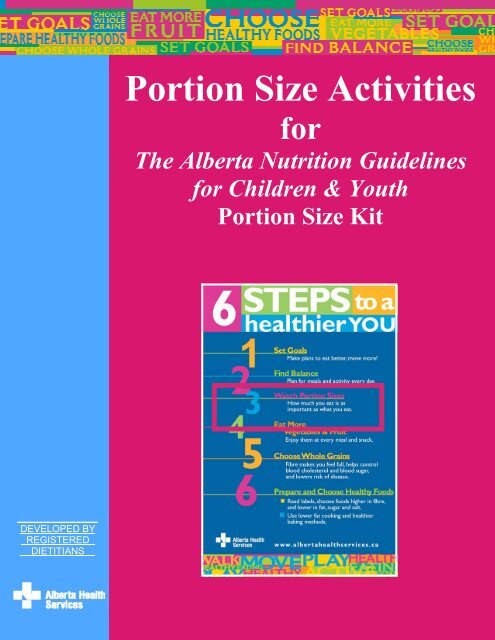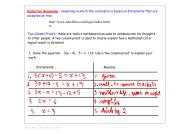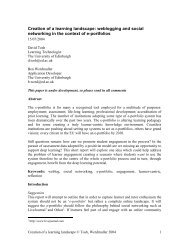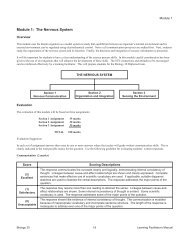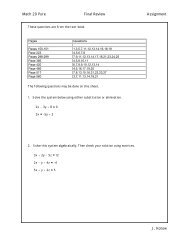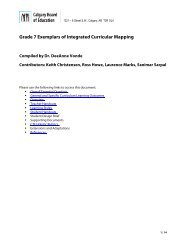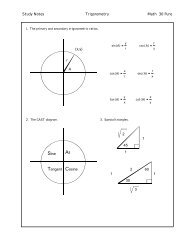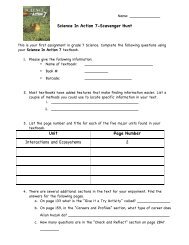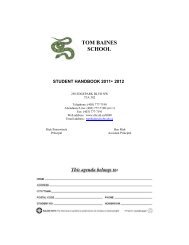Activities For The Alberta Nutrition Guidelines Portion Size Kit ...
Activities For The Alberta Nutrition Guidelines Portion Size Kit ...
Activities For The Alberta Nutrition Guidelines Portion Size Kit ...
- No tags were found...
You also want an ePaper? Increase the reach of your titles
YUMPU automatically turns print PDFs into web optimized ePapers that Google loves.
Acknowledgement<strong>The</strong> development of this resource is made possible through the assistance of HealthyWeights Facilitators as part of the Healthy Weights Initiative funded by <strong>Alberta</strong> Healthand Wellness.© 2009 <strong>Alberta</strong> Health ServicesMaterial from this booklet may be copied in its entirety without alteration foreducational purposes.-2-
Contents<strong>Portion</strong> <strong>Size</strong> <strong>Activities</strong> for the <strong>Alberta</strong> <strong>Nutrition</strong> <strong>Guidelines</strong> <strong>Portion</strong> <strong>Size</strong> <strong>Kit</strong> ...................4What’s in the <strong>Alberta</strong> <strong>Nutrition</strong> <strong>Guidelines</strong> <strong>Portion</strong> <strong>Size</strong> <strong>Kit</strong>? ............................................5Background Information: Healthy <strong>Portion</strong> <strong>Size</strong>s ................................................................6Learning Outcomes for <strong>Portion</strong> <strong>Size</strong> <strong>Activities</strong>...................................................................7Basic <strong>Activities</strong>:What is a Healthy Food Choice? (All ages) .............................................................................9What is a Healthy Serving <strong>Size</strong>? (All ages) .............................................................................11Building a Healthy Plate Placemat (Kindergarten to Grade 3)……………………………………13Advanced <strong>Activities</strong>:Building an International Healthy Plate (Grade 4 to 6)............................................................ 16Building a Healthy Fast Food Plate (Grade 7 to 9) ................................................................. 19Building a Healthy Menu Plan (Grade 10 to 12)...................................................................... 22Reference ............................................................................................................................. 24Classroom Resources<strong>The</strong> following resources are used in the <strong>Portion</strong> <strong>Size</strong> activities and are available on-line in PDF format orcan be ordered free of charge.Eating Well with Canada’s Food Guide(Allow 2 weeks delivery if ordering free copies)http://www.hc-sc.gc.ca/fn-an/food-guide-aliment/index-eng.phpFood Serving <strong>Size</strong>s for Children 6 to 12 years oldhttp://www.healthyalberta.ca/AboutHealthyU/280.htmFood Serving <strong>Size</strong>s <strong>For</strong> 13 to 18 year oldshttp://www.healthyalberta.ca/AboutHealthyU/280.htm-3-
<strong>Portion</strong> <strong>Size</strong> <strong>Activities</strong> for the <strong>Alberta</strong> <strong>Nutrition</strong> <strong>Guidelines</strong> <strong>Portion</strong><strong>Size</strong> <strong>Kit</strong>A healthy food choice includes not only the type of food, but also the portion size and how it is prepared.<strong>Alberta</strong> Health and Wellness has created several tools to help organizations and individuals identifyhealthy food options.<strong>The</strong> <strong>Alberta</strong> <strong>Nutrition</strong> <strong>Guidelines</strong> for Children and Youth (2008) are designed to help <strong>Alberta</strong>ns createenvironments which provide healthy food choices and promote healthy eating habits wherever food isoffered to children. To view the complete <strong>Guidelines</strong> and download your copy, visit: www.healthyalberta.ca<strong>The</strong> <strong>Alberta</strong> <strong>Nutrition</strong> <strong>Guidelines</strong> <strong>Portion</strong> <strong>Size</strong> <strong>Kit</strong> (2009) is a tool designed to help teach about healthyportion sizes. <strong>The</strong> blue lunch bag contains common items that are easily recognized by children. Eachitem represents one Canada’s Food Guide Serving of certain kinds of foods. <strong>The</strong> educational activitiesdescribed in this booklet are designed to accompany the <strong>Portion</strong> <strong>Size</strong> <strong>Kit</strong>.Why is portion size important?<strong>Portion</strong> sizes of food purchased outside the home, such as restaurant and convenience foods, haveincreased over the past twenty years. 1,2 Many of these foods are high in fat, sugar and/or salt. As a result,children may be consuming larger portions of unhealthy foods. According to Statistics Canada, Canadianchildren are not meeting the recommended servings for healthy food choices from Canada’s Food Guide. 3Research shows:• 70% of children aged 4 to 8 years are eating less than the recommended servings of Vegetablesand Fruit per day. 3• 61% of boys and 83% of girls aged 10 to 16 years do not meet their daily minimum requirementsof 3 servings of Milk and Alternatives per day. 3• 22% of children’s calories are from food and beverages that are high in fat, sugar and salt. 3Larger portion sizes and unhealthy food choices contribute to the rising rates of childhood obesity andoverweight. 4 Furthermore, poor eating habits may also be carried into adulthood and increase the risk ofchronic diseases, such as diabetes, heart disease and certain types of cancer. 5 It is important that childreneat healthy food, and choose portions that are appropriate for their age and activity level. How muchindividuals eat is as important as what they eat.-4-
What’s in the <strong>Alberta</strong> <strong>Nutrition</strong> <strong>Guidelines</strong> <strong>Portion</strong> <strong>Size</strong> <strong>Kit</strong>?<strong>The</strong> <strong>Alberta</strong> <strong>Nutrition</strong> <strong>Guidelines</strong> <strong>Portion</strong> <strong>Size</strong> <strong>Kit</strong> contains common items that are easily recognized bychildren. <strong>The</strong> following table shows the items found in the <strong>Kit</strong>, the quantities and the Food Guide Servingsthat each item represents.Serving <strong>Size</strong>ItemQuantityRepresentedFood RepresentedOne Food GuideServingSaladVegetables and Fruit250 mL (1 cup)Cold cerealGrain ProductsBaseballMilkMilk and AlternativesHot cerealGrain Products175 mL (¾ cup)YogurtMilk and AlternativesTennis ballBeans, lentils or tofuMeat and AlternativesHockey puck125 mL (½ cup)125 mL (½ cup)Fresh, frozen or cannedvegetables and fruitRice, pasta, bulgur, quinoa,couscous, ½ large bagelVegetables & FruitGrain Products75 g (2 ½ oz) Fish, shellfish, poultry, lean meat Meat and Alternatives2 White Erasers50 g (1 ½ oz) Cheese Milk and AlternativesGolf Ball30 mL (2 Tbsp) Peanut or nut butter Meat and Alternatives2 Golf Balls60 mL (¼ cup)Dried fruitNuts and seedsVegetables and FruitMeat and Alternatives<strong>The</strong> <strong>Kit</strong> also includes 40 Food <strong>Portion</strong> Cards. <strong>The</strong>se cards have a picture of a food with the correspondingserving size item on one side, and the nutrition facts for that food on the other side. Healthy PlateFrisbees® are also part of the <strong>Kit</strong>. <strong>The</strong> Frisbee® shows an example of a well balanced meal; and theoutside edge demonstrates a healthy plate size.-5-
Background Information: Healthy <strong>Portion</strong> <strong>Size</strong>s<strong>The</strong> following questions and answers can be used to teach students about the importance of portion sizesfor a healthy diet.What is the difference between a portion size and a serving size?Generally, a "portion" is defined as the amount of food a person eats at any one time. A “serving" is thestandard amount shown on Canada’s Food Guide.<strong>For</strong> example, one serving of pasta is 125 mL (½ cup) or a “hockey puck”, according to Canada’s FoodGuide. In comparison, a typical portion of pasta served in restaurants is three cups(750 mL), which is equal to six servings from Canada’s Food Guide.What is healthy eating?Healthy eating means eating a variety of foods from all four food groups on Canada’s Food Guideeveryday. A balanced meal includes food from at least 3 of the 4 food groups. A healthy snack has at least2 food groups. To ensure you are eating a balanced meal, try using the Healthy Plate method below.How do I build a Healthy Plate?Imagine your plate divided into three sections like the picture below. At least half (½) of your plate shouldbe Vegetables and Fruit. <strong>The</strong> other half of your plate can be split into two quarters. One quarter (¼) is forGrain Products and one quarter (¼) for Meat and Alternatives. Complete the meal with a choice from milkand alternatives, for example, 1 cup (250 mL) of milk.Choose a medium sized plate (about the size of a Frisbee®) to help you keep your portions healthy. If youhave a large plate, fill only the middle of the plate. Don’t fill a larger plate right to the edge with food.Meat and Alternatives¼ of the plateGrain Products¼ of the plateVegetables and Fruit½ of the plate-6-
Learning Outcomes for <strong>Portion</strong> <strong>Size</strong> <strong>Activities</strong><strong>The</strong> classroom activities in this booklet are linked to <strong>Alberta</strong> Education Health & Life Skills and Careerand Technology Studies: Foods outcomes. Please see table below for activities related to each learningoutcome.<strong>Alberta</strong> Education Learning Outcomes <strong>Portion</strong> <strong>Size</strong> Activity PageNumberW-K.5:Recognize that nutritious foods are needed for growthand to feel good/have energy; e.g. nutritious snacks.Building A Healthy Plate Placemat Page 11W-1.5Recognize the importance of basic, healthy, nutritionalchoices to well-being of self; e.g., variety of food,drinking water, eating a nutritious breakfast.W-2.5Classify foods according to Canada’s Food Guide toHealthy Eating, and apply knowledge of food groups toplan for appropriate snacks and meals.W-3.5Apply guidelines from Canada’s Food Guide to HealthyEating to individual nutritional circumstances; e.g., activechildren eat/drink more.W-4.5Analyze the need for variety and moderation in abalanced diet; e.g., role of protein, fats, carbohydrates,minerals, water, vitamins.W-5.5Examine ways in which healthy eating canaccommodate a broad range of eating behaviours; e.g.,individual preferences, vegetarianism, cultural foodpatterns, allergies/medical conditions, diabetes.W-6.5Analyze personal eating behaviours – food and fluids –in a variety of settings; e.g., home, school, restaurants.Building A Healthy Plate Placemat Page 11What is a healthy food choice? Page 7Building A Healthy Plate Placemat Page 11What is a healthy food choice? Page 7Building A Healthy Plate Placemat Page 11What is a healthy food choice? Page 7What is a healthy serving size? Page 9Building an International Plate Page 14What is a healthy food choice? Page 7What is a healthy serving size? Page 9Building an International Plate Page 14What is a healthy food choice? Page 7What is a healthy serving size? Page 9Building an International Plate Page 14Building a Healthy Fast Food Plate Page 17-7-
Learning Outcomes for <strong>Portion</strong> <strong>Size</strong> <strong>Activities</strong> Continued<strong>Alberta</strong> Education Learning Outcomes <strong>Portion</strong> <strong>Size</strong> Activity PageNumberW-7.5What is a healthy food choice? Page 7Relate the factors that influence individual food choicesto nutritional needs of adolescents; e.g., finances, media,peer pressure, hunger, body image, activity.What is a healthy serving size? Page 9Building a Healthy Fast Food Plate Page 17W-8.5Evaluate personal food choices, and identify strategiesto maintain optimal nutrition when eating away fromhome; e.g., eating healthy fast foods.What is a healthy food choice? Page 7What is a healthy serving size?Page 9Building a Healthy Fast Food Plate Page 17W-9.5Develop strategies that promote healthy nutritionalchoices for self and others; e.g., adopt goals that reflecthealthy eating, encourage the placement of nutritiousfood in vending machines.CTS- Foods – Module FOD1010 Food & <strong>Nutrition</strong>BasicsDescribe food choices in relation to Canada’s FoodGuide to Healthy EatingWhat is a healthy food choice? Page 7What is a healthy serving size? Page 9Building a Healthy Fast Food Plate Page 17What is a healthy food choice? Page 7What is a healthy serving size? Page 9CTS- Foods – Module FOD 2010 Food & <strong>Nutrition</strong>Basics - identify and describe the interrelationshipsamong food choices, nutrients and wellnessCTS- Foods – Module FOD 3010 Food & <strong>Nutrition</strong>Basics describe the role food plays in the development,enhancement and maintenance of physical, emotionaland social wellness throughout the life cycle.Building a Healthy Menu PlanPage 20-8-
Activity: What is a healthy food choice? (All ages)Objectives:• Students will be able to assign foods to correct food groups in Canada’s Food Guide.• Students will gain a better understanding of healthy food choices from Canada’s Food Guide.Key Messages• Canada’s Food Guide divides healthy food choices into four groups: Vegetables and Fruit, GrainProducts, Milk and Alternatives and Meat and Alternatives. Each food group provides nutrients thatare required for a healthy body. Healthy eating includes foods from all four food groups everyday.• Some foods are not found in Canada’s Food Guide. <strong>The</strong>se foods are high in calories, fat, sugar,and/or salt, and should be limited for everyone. Examples of these foods are pop, candy, chocolate,cookies, french fries, and salty snacks.Required Items: (see page 3 to order or download resources)• Eating Well with Canada’s Food Guide (enough copies for each student)• Food <strong>Portion</strong> Cards (found in <strong>Alberta</strong> <strong>Nutrition</strong> <strong>Guidelines</strong> <strong>Portion</strong> <strong>Size</strong> <strong>Kit</strong>)Instructions:1. Lead a discussion on Canada’s Food Guide using the questions and answers outlined below. Ensurethe students have time to share their answers.Questions and AnswersQuestion Who can name one of the four food groups from Canada’s Food Guide? Repeatthis question until the class has provided an answer for all the four food groups.Answer • Vegetables and Fruit • Milk and Alternatives• Grain Products• Meat and AlternativesOptional • Hold up a variety of the Food Picture Cards found in the <strong>Kit</strong> and ask students toidentify which food group the food item belongs in.• Food groups are labeled on the back of the picture card, i.e. Peanut butter cardbelongs to the Meat and Alternatives food group.-9-
Activity: What is a healthy food choice? (continued)2. Provide each student with a copy of Canada’s Food Guide and continue with the following discussionquestions.Questions and AnswersQuestion Why is it important to eat Vegetables and Fruit?Answer • Vegetables and Fruit give our body energy to be active.• Vegetables and Fruit have many important vitamins and minerals (asreference: folate, vitamin B 6 , vitamin C, vitamin A, magnesium andpotassium). 6• Vegetables and Fruit have fibre. Fibre is important for keeping our bowelsfunctioning properly and our digestive tract healthy. Fibre also makes us feelfull so we may not overeat, which helps us maintain a healthy weight. 7,8• Eating plenty of Vegetables and Fruit may help reduce the risk of heartdisease, stroke and some types of cancer. 6,8Question Why is it important to eat Grain Products?Answer • Grain Products are the body’s favourite source of energy for activity.• Whole grains provide vitamins, minerals and fibre. 6• Eating plenty of whole grains can help reduce your risk of heart disease. 6Question Why is it important to have Milk and Alternatives?Answer • Milk and Alternatives have calcium and vitamin D, which help to keep ourbones and teeth healthy and strong. 6Question Why is it important to eat Meat or Alternatives?Answer • Meat and Alternatives, such as beans, tofu, and lentils, are high in proteinwhich is important for strong muscles.• Protein is also needed for growth.Emphasize that healthy eating includes choosing foods from all the four food groups. Thisensures that you are getting all the nutrients your body needs and contributes to overallhealth.<strong>For</strong> more background information on Canada’s Food Guide and specific nutrients, see “Eating Well with Canada’sFood Guide: A Resource for Educators and Communicators”. Available online at:http://www.hc-sc.gc.ca/fn-an/food-guide-aliment/index-eng.php-10-
Activity: What is a healthy serving size? (All ages)Objective:• Students will be able to identify how many Food Guide Servings they need in a day.• Students will be able to identify the appropriate serving size model according to one Food GuideServing.Key Messages:• Canada’s Food Guide provides a range of servings for each food group according to age and gender.This ensures that people meet their requirements for vitamins, minerals, energy and nutrients.• Different people need different numbers of servings from each food group every day. <strong>The</strong> number ofservings a person needs will depend on body size, activity level, age, growth pattern and gender.• How much people eat is as important as what they eat.Required Items: (see page 3 to order or download resources)• <strong>Alberta</strong> <strong>Nutrition</strong> <strong>Guidelines</strong> <strong>Portion</strong> <strong>Size</strong> <strong>Kit</strong>• Eating Well with Canada’s Food Guide (enough copies for each student)• <strong>Alberta</strong> Health and Wellness: Food Guide Serving <strong>Size</strong> handout (6 to 12 or 13 to 18 years)Instructions:1. Lead a discussion on Canada’s Food Guide using the questions and answers outlined below. Ensurethe students have time to share their answers.Questions and AnswersQuestion How many servings do you need from each of the four food groups everyday?(Have the students find their age category on the chart titled “RecommendedNumber of Food Guide Servings Per Day” on Canada’s Food Guide.)Answer<strong>The</strong> answer will vary depending on the age group of the class. <strong>For</strong> example, ifmost of the students in the class are age 12, then they would need:• 6 servings of Vegetables and Fruit• 6 servings of Grain Products• 3 to 4 servings of Milk and Alternatives• 1 to 2 servings of Meat and Alternatives in a day.-11-
Activity: What is a healthy serving size? (continued)Questions and AnswersQuestion What is one Food Guide Serving of Vegetables and Fruit? (Have the studentsrefer to the “What is One Food Guide Serving” picture examples on Canada’sFood Guide.)Answer Hold up corresponding serving size model• Fresh, frozen or canned vegetables and fruit = ½ cup (125 mL) = 1 hockeypuck• Leafy vegetables = 1 cup (250 mL) = 1 baseballQuestionAnswerQuestionAnswerQuestionAnswerWhat is one Food Guide Serving of Grain Products? (Have the students refer tothe “What is One Food Guide Serving” picture examples on Canada’s FoodGuide.)Hold up corresponding serving size model• ½ bagel = 45 g = 1 hockey puck• Cooked rice, pasta, bulgur, quinoa, couscous = ½ cup (125 mL) = 1 hockeypuck• Cold cereal = ~ 1 cup (30 g) = 1 baseball• Hot cereal = ¾ cup (175 mL) = 1 tennis ballWhat is one Food Guide Serving of Milk and Alternatives? (Have the studentsrefer to the “What is One Food Guide Serving” picture examples on Canada’sFood Guide.)Hold up corresponding serving size model• Milk or soy beverage = 1 cup (250 mL) = 1 baseball• Yogurt = ¾ cup (175 mL) = 1 tennis ball• Cheese = 1 ½ oz (50 g) = 2 erasersWhat is one Food Guide Serving of Meat and Alternatives? (Have the studentsrefer to the “What is One Food Guide Serving” picture examples on Canada’sFood Guide.)Hold up corresponding serving size model• Cooked fish, poultry, lean meats = 75 g (2 ½ oz) = 1 hockey puck• Cooked legumes = ¾ cup (175 mL) = 1 tennis ball• Peanut or nut butters = 2 Tbsp (30 mL) = 1 golf ballEmphasize that healthy eating includes foods from all the four food groups, as well aschoosing appropriate portion sizes. This ensures that you are getting all the nutrients yourbody needs and contributes to overall health.<strong>For</strong> more background information on Canada’s Food Guide and specific nutrients, see “Eating Well with Canada’sFood Guide: A Resource for Educators and Communicators”. Available online at: http://www.hc-sc.gc.ca/fn-an/foodguide-aliment/index-eng.php-12-
Activity: Building a Healthy Plate Placemat(Kindergarten to Grade 3)Objectives:• Students are able to choose foods from Canada’s Food Guide to create a healthy meal.Key Messages:• Healthy eating means eating a variety of foods from all the four food groups everyday.• <strong>The</strong> Healthy Plate method is a great way to ensure a well balanced meal. A healthy plate includes: atleast half (½) of the plate filled with Vegetables and Fruit. <strong>The</strong> other half of the plate is divided into twoquarters. One quarter (¼) for Grain Products, and one quarter (¼) for Meat and Alternatives.Complete the meal with a choice from Milk and Alternatives, such as a glass of milk or a serving ofyogurt.• A healthy breakfast includes food from at least three of the four food groups.• A healthy lunch or supper includes foods from all four food groups.Required Items: (see page 3 to order or download resources)• Eating Well with Canada’s Food Guide (one copy for each student)• Food <strong>Portion</strong> Cards (found in <strong>Alberta</strong> <strong>Nutrition</strong> <strong>Guidelines</strong> <strong>Portion</strong> <strong>Size</strong> <strong>Kit</strong>)• Healthy Plate Frisbee® (found in <strong>Alberta</strong> <strong>Nutrition</strong> <strong>Guidelines</strong> <strong>Portion</strong> <strong>Size</strong> <strong>Kit</strong>)• <strong>Alberta</strong> Health and Wellness: Food Guide Serving <strong>Size</strong> handout (6 to 12 years)• “My Healthy Plate” picture worksheet found on page 13 (one copy for each student)• MagazinesInstructions:1. Remove “Mixed Dishes” Picture Cards from Food <strong>Portion</strong> Cards set, and shuffle remaining cards.(Food groups are labeled on the back of the picture card.)2. As a class, look at each Food <strong>Portion</strong> Card and determine which Food Group the food item on thecard belongs in. This will reinforce which foods belong to the four food groups.<strong>The</strong> answer can be found on the back of the card.3. Explain to the students what a healthy plate looks like using the Frisbee®. Refer to BackgroundInformation: How Do I Build a Healthy Plate? on page 6.4. Provide one “My Healthy Plate” worksheet to each student.-13-
Activity: Building a Healthy Plate Placemat (continued)5. Assign each student either lunch or supper.6. Have the students find pictures of food from magazines that they might eat at the meal they areassigned. (Option: have students draw and colour foods they would like for their meal).7. Using the “My Healthy Plate” worksheet, encourage the students to fill ½ the plate with Vegetablesand Fruit, ¼ with Grain Products and ¼ with Meat and Alternatives. Complete the meal with a choicefrom Milk and Alternatives, such as a glass of milk or a serving of yogurt.8. Have the students paste their food pictures onto their plate.9. You may wish to paste their completed “My Healthy Plate” onto construction paper and laminate themfor placemats.Optional for older students:When the students are finished, ask:• What food groups are represented on their “My Healthy Plate”?• What serving size model (e.g. hockey puck), would correspond to the food item they chose? <strong>For</strong>example: ¼ plate of Grain Products choice could be pasta, which is represented by a hockey puck = 1serving (½ cup). This is an appropriate serving size for this age group.• Do the portions in their pictures correspond to the serving size model(s) for that food? <strong>For</strong> example,one Food Guide Serving of cheese 50 g (1 ½ oz) corresponds to 2 white erasers.-14-
My Healthy PlateName: __________________________Meal: _______________________-13--15-
Activity: Building an International Healthy Plate (Grade 4 to 6)Objectives:• Students are able to choose foods from Canada’s Food Guide to create an internationalhealthy meal. (Please note, this activity may take more than one class period to complete.)Key Messages:• Healthy eating means eating a variety of foods from all the four food groups everyday.• Healthy eating includes a range of eating behaviors, including various cultural eating patterns.• <strong>The</strong> Healthy Plate method is a great way to ensure a well balanced meal. A healthy plateincludes: at least half (½) of the plate filled with Vegetables and Fruit. <strong>The</strong> other half of theplate is divided into two quarters. One quarter (¼) for Grain Products, and one quarter (¼) forMeat and Alternatives. Complete the meal with a choice from Milk and Alternatives, such as aglass of milk or a serving of yogurt.• How much people eat is as important as what they eat.• A healthy breakfast includes food from at least three of the four food groups.• A healthy lunch or supper includes foods from all four food groups.Required Items: (see page 3 for ordering or downloading resources)• Eating Well with Canada’s Food Guide (one copy for each student)• Food <strong>Portion</strong> Cards (found in <strong>Alberta</strong> <strong>Nutrition</strong> <strong>Guidelines</strong> <strong>Portion</strong> <strong>Size</strong> <strong>Kit</strong>)• Healthy Plate Frisbees® (found in <strong>Alberta</strong> <strong>Nutrition</strong> <strong>Guidelines</strong> <strong>Portion</strong> <strong>Size</strong> <strong>Kit</strong>; provide oneFrisbee® per 2 to 3 students)• <strong>Alberta</strong> Health and Wellness: Food Guide Serving <strong>Size</strong> handout (6 to 12 years)• “Building an International Healthy Plate” worksheet found on page 16 (one copy for eachgroup)Instructions:1. As a class, go through each Food <strong>Portion</strong> Card and determine which Food Group the food itemon the card belongs in. Note: Mixed Dishes Food <strong>Portion</strong> Cards will contain more than oneFood Group.2. Explain to the students what a healthy plate looks like. Refer to Background Information: AHealthy Plate on page 6. You may also wish to use the example provided on the back page ofEating Well with Canada’s Food Guide: “How do I count Food Guide Servings in a meal?”3. Divide the class into groups of two or three students.-16-
Activity: Building an International Healthy Plate (continued)4. Provide each group with the “Building an International Healthy Plate” worksheet and theHealthy Plate Frisbee®.5. Assign each group a country (e.g. India, Somalia, Philippines).6. Ask the students to research what would be a typical lunch and supper for their country.7. Following the Healthy Plate method, have each group fill in the worksheet.Additional Learning Opportunities:• Ask students to identify which serving size model (i.e. hockey puck), would correspond to thefood item they chose. <strong>For</strong> example: A Food Guide serving size of Couscous, which is a primarystaple throughout much of Morocco, Algeria, Tunisia and Libya, is represented by a hockeypuck = ½ cup.• Ask each group to do a short presentation on their country and the foods they chose.• Use the Eating Well with Canada’s Food Guide: First Nations, Inuit & Métis for an alternateactivity.Note: <strong>The</strong> Health Canada website also has an interactive tool, My Food Guide, which lists a variety ofcultural foods. <strong>For</strong> more information, see http://www.hc-sc.gc.ca/fn-an/food-guide-aliment/index-eng.php-17-
Name: _________________________________Date: ____________________________Building an International Healthy PlateCountry: _________________________________________________Lunch:Vegetables and Fruit: ________________________________________________________________Grain Products: _____________________________________________________________________Milk and Alternatives: ________________________________________________________________Meat and Alternatives: _______________________________________________________________Supper:Vegetables and Fruit: ________________________________________________________________Grain Products: _____________________________________________________________________Internet Explorer.LnkMilk and Alternatives: _______________________________________________Meat and Alternatives: _______________________________________________________________Remember, a healthy meal includes foods from all 4 food groups.-18-
Activity: Building a Healthy Fast Food Plate (Grade 7 to 9)Objectives:• Students are able to choose foods from Canada’s Food Guide to create a healthy fast foodmeal. (Please note, this activity may take more than one class period to complete.)Key Messages:• <strong>Portion</strong> sizes of food purchased outside the home, such as restaurant and convenience foods,have increased over the past twenty years. 1,2 Many of these foods are high in fat, sugar and/orsalt. As a result, children may be consuming larger portions of unhealthy foods.• <strong>The</strong> Healthy Plate method is a great way to ensure a well balanced meal. A healthy plateincludes: at least half (½) of the plate filled with Vegetables and Fruit. <strong>The</strong> other half of theplate is divided into two quarters. One quarter (¼) for Grain Products, and one quarter (¼) forMeat and Alternatives. Complete the meal with a choice from milk and alternatives, such as aglass of milk or a serving of yogurt.• How much people eat is as important as what they eat.• A healthy breakfast includes food from at least three of the four food groups.• A healthy lunch or supper includes foods from all four food groups.Required Items: (see page 3 to order or download resources)• Eating Well with Canada’s Food Guide (one copy for each student)• <strong>Alberta</strong> Health and Wellness: Food Guide Serving <strong>Size</strong> handout (13-18 years)• Healthy Plate Frisbees® (found in <strong>Alberta</strong> <strong>Nutrition</strong> <strong>Guidelines</strong> <strong>Portion</strong> <strong>Size</strong> <strong>Kit</strong>)• “Building a Healthy Fast Food Plate” worksheet found on page 19 (one copy for each group)Instructions:1. Review Canada’s Food Guide (See first two activities on pages 7 and 9).2. Divide the class into groups of two or three students.3. Provide each group a “Building a Healthy Fast Food Plate” worksheet and the Healthy PlateFrisbee®.4. Assign each group a fast food restaurant. (See website examples on the following page.)5. Have the students research a healthy option for a lunch and supper using the menus from therestaurants.-19-
Activity: Building a Healthy Fast Food Plate (continued)6. Following the Healthy Plate method, each group will fill in the “Building a Healthy Fast Food”worksheet. (Students may refer to the Healthy Plate Frisbee® for this activity.)7. Ask students to identify which serving size model (e.g. hockey puck), would correspond to thefood item they chose. <strong>For</strong> example: A Food Guide serving size of a hamburger patty, isrepresented by a hockey puck = 75 g (2 ½ oz). How many Food Guide Servings are in a typicalrestaurant portion?Additional Learning Opportunities:• Ask the students to compare the portions served in the assigned restaurant to the portion itemsin the <strong>Kit</strong>. Is it difficult to create a Healthy Plate from the portions served in the restaurant?• Ask each group to do a short presentation on their restaurants and the foods they chose.Restaurants websites:A & W ® : http://www.aw.ca/publicinfo.nsf/nutrition-nutrientsMcDonald’s ® : http://www.mcdonalds.ca/en/index.aspx (nutrition calculator)Taco Time ® : http://www.tacotimecanada.com/pdf/2010-12347%20<strong>Nutrition</strong>al%20v2.pdfBoston Pizza ® : http://www.bostonpizza.com/files/pdfmenu/bp/E1_menu.pdfSwiss Chalet ® : http://www.swisschalet.com/our_menu.phpDairy Queen ® : http://www.dairyqueen.com/us-en/eats-and-treats/Subway ® : http://www.subway.caEdo Japan ® : http://www.edojapan.comTim Hortons ® : htttp://www.timhortons.comPlease note this is just a small sample of common fast food restaurants, use as appropriate.-20-
Name: _________________________________Date: ____________________________Building a Healthy Fast Food PlateRestaurant: ___________________________________________________Lunch:Vegetables and Fruit: _______________________________________________________________Grain Products: ____________________________________________________________________Milk and Alternatives: _______________________________________________________________Meat and Alternatives: ______________________________________________________________Supper:Vegetables and Fruit: _______________________________________________________________Grain Products: ____________________________________________________________________Milk and Alternatives: _______________________________________________________________Meat and Alternatives: ______________________________________________________________Remember, a healthy meal includes foods from all 4 food groups.-21-
Activity: Building a Healthy Menu Plan (Grade 10 to 12)Objectives:• Students are able to choose foods from Canada’s Food Guide to create a healthy meal for avariety of age groups and their nutrition requirements. (Please note, this activity may take morethan one class period to complete.)Key Messages:• Different people need different number of servings from each food group every day. <strong>The</strong>number of servings a person needs will depend on body size, activity level, age, growth patternand gender.• It is important for people to have foods from all four food groups in order to meet theirnutritional requirements.• <strong>The</strong> Healthy Plate method is a great way to ensure a well balanced meal. A healthy plateincludes: at least half (½) of the plate filled with Vegetables and Fruit. <strong>The</strong> other half of theplate is divided into two quarters. One quarter (¼) for Grain Products, and one quarter (¼) forMeat and Alternatives. Complete the meal with a choice from Milk and Alternatives, such as aglass of milk or a serving of yogurt.• How much people eat is as important as what they eat.• A healthy breakfast includes food from at least three of the four food groups.• A healthy lunch or supper includes foods from all four food groups.Required Items: (see page 3 to order or download resources)• Eating Well with Canada’s Food Guide (one copy for each student)• <strong>Alberta</strong> Health and Wellness: Food Guide Serving <strong>Size</strong> handout (13-18 years)• Healthy Plate Frisbee® (found in <strong>Alberta</strong> <strong>Nutrition</strong> <strong>Guidelines</strong> <strong>Portion</strong> <strong>Size</strong> <strong>Kit</strong>)Instructions:1. Divide the class into groups of two or three students.2. Assign each group a scenario of a person with unique food preferences or requirements Seeoptions below or create your own.• 45 year old male with Celiac disease (gluten free diet). A suggested website for moreinformation: http://www.celiac.ca/EnglishCCA/egfdiet.html• 2 year old female with Cow’s Milk allergy. A suggested website for more information:http://www.inspection.gc.ca/english/fssa/labeti/allerg/milklaite.shtml• 18 year old male Vegetarian. A suggested website for more information:http://www.capitalhealth.ca/Especially<strong>For</strong>/WeightWise/Special_Considerations_for_Vegetarian_Eating• 21 year old female Vegan. A suggested website for more information:http://www.capitalhealth.ca/Especially<strong>For</strong>/WeightWise/Special_Considerations_for_Vegetarian_Eating-22-
Activity: Building a Healthy Menu Plan (continued)3. Have each group create a menu plan for one day; including 3 meals and 2 snacks. (Note:healthy meals contain foods from at least three of the four food groups from Canada’s FoodGuide and snacks contain at least two food groups. Students may refer to the Healthy PlateFrisbee as an example of a healthy meal.)4. <strong>The</strong> menu plan must meet the recommended servings based on age and gender according toCanada’s Food Guide.Additional Questions:• Does your menu take into consideration a Healthy Plate for each meal? If not, discuss why andcome up with ideas to improve your menu(s).Additional Learning Opportunities:• Ask students to record what they eat over the next 3 days. Based on the Healthy Plate andCanada’s Food Guide recommendations, ask students to analyze their intake. Are any foodgroups missing? Do their meals follow the Healthy Plate model? How can they meet Canada’sFood Guide recommendations?Example for a 6 year old boy:MealBreakfastSnackLunchVegetablesand FruitStrawberries(¼ cup)Apple Sauce(½ cup)Cherry Tomatoes(¼ cup)Watermelon(½ cup)GrainProductsOatmeal(½ cup)Whole WheatBread (2 slices)Milk andAlternativesMilk (¼ cup)Yogurt(½ cup)Cheese (25 g)Meat andAlternativesHam slices(37 ½ g)SnackCelery (½ cup)Raisins (¼ cup)Peanut Butter(1 Tbsp)Supper Salad (½ cup) Pasta (½ cup) Milk (½ cup) Meat Sauce(¼ cup)Total Servings 5 ¼ 4 3 1 ½Canada’sFood GuideRecommendations5 4 2 1-23-
Additional <strong>Portion</strong> <strong>Size</strong> <strong>Activities</strong><strong>The</strong> <strong>Alberta</strong> Health Services <strong>Portion</strong> Wise <strong>Kit</strong> Manual has additional curriculum-based activitiesfor students in grades 4 to 9. Available online as a PDF on the School Health Website:www.capitalhealth.ca/schoolsandpreschools (search for “<strong>Portion</strong> Wise”).Reference1. Young LR, Nestle M. Expanding portion sizes in the US marketplace: Implications for nutritioncounseling. J Am Diet Assoc 2003;103:231-4.2. Young LR, Nestle M. <strong>The</strong> contribution of expanding portion sizes to the US obesity epidemic.Am J Public Health 2002;92:246-9.3. Statistics Canada. Canadian Community Health Survey: Overview of Canadians’ Eating Habits[Online]. 2006 [cited 2009 Mar 30]; Available from:URL:http://www.statcan.ca/Daily/English/060706/d060706b.htm4. World Health Organization. WHO Information on School Health Document Four. Healthy<strong>Nutrition</strong>: An Essential Element of a Health- Promoting School [Online]. 1998 p. 5. [cited 2008Sept 22]; Available from: URL:http://www.who.int/school_youth_health/media/en/428.pdf5. Ontario Society of <strong>Nutrition</strong> Professionals in Public Health School <strong>Nutrition</strong> Workgroup SteeringCommittee. Call to Action: Creating a Healthy School <strong>Nutrition</strong> Environment [Online]. 2004;Available from: URL:http://www.osnpph.on.ca/pdfs/call_to_action.pdf6. Health Canada. Eating Well With Canada’s Food Guide: A Resource for Educators andCommunicators [Online]. 2007 [cited 2009 Apr 1]; Available from: URL:http://www.hcsc.gc.ca/fn-an/alt_formats/hpfb-dgpsa/pdf/pubs/res-educat-eng.pdf7. <strong>The</strong> National Academic Press. Dietary Reference Intakes <strong>For</strong> Energy Carbohydrates, Fibre,Fat, Protein, and Amino Acids (Macronutrients) [Online]. 2002 [cited 2009 Apr 1]; Availablefrom: URL:http://books.nap.edu/openbook.php?isbn=03090853738. Mayo Clinic. Dietary Fibre: An Essential Part of a Healthy Diet [Online]. 2007 [cited 2009 Mar31]; Available from: URL:http://www.mayoclinic.com/health/fiber/NU000339. Health Canada. Eating Well With Canada’s Food Guide First Nations, Inuit and Metis [Online].2007 [cited 2009 Apr 2]; Available from: URL: http://www.hc-sc.gc.ca/fn-an/alt_formats/fnihbdgspni/pdf/pubs/fnim-pnim/2007_fnim-pnim_food-guide-aliment-eng.pdf10. Health Canada. My Food Guide [Online]. 2007 [cited 2009 Apr 3]; Available from:URL:http://www.hc-sc.gc.ca/fn-an/food-guide-aliment/myguide-monguide/index-eng.php-24-


